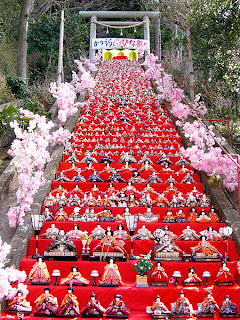Shichi Go San is a naming ceremony in Japan that celebrates the growth of children age 3, 5, and 7 years. The celebration carried out by parents every year around November 15, and is not a holiday.
Shichi go san literally means "seven, five, and three." This age is considered to be important in the life of a child. In particular, at the age of seven, a young girl celebrates wearing the first obi, while at the age of five years of a young boy celebrates wearing his first shorts in public. Age three marks the first time where both boys and girls are allowed to let their hair grow.
Age is believed to be a milestone in life, and odd numbers according to Chinese tradition believed to bring good luck. Children who are old enough to be participants Shichi Go San dressed in a kimono and taken to a Shinto shrine to pray. Their parents take advantage of this opportunity to capture a child - his son who was well dressed with a picture taken at a photo studio.
Brief History
In the old days, a child mortality rate is very high that the tradition of celebrating the birth of children who reach a certain age among family farmers in Japan. This tradition extends to the samurai who added a number of ceremonies. Girls and boys aged 3 years following the ceremony marking the start dipanjangkannya Kamioki child's hair after previously always been shaved off. Children aged 5 years follow-gi hakama ceremony that marked the first time the child begins to wear hakama and haori. The daughter followed the ceremony Obitoki Himo-otoshi marks the change of kimono worn girls, from kimono children roped into the following kimono obi such as those used for adults. Shichi Go San opportunity is often the first opportunity for girls to make up her face.
The festival began in the Heian period (794-1185) in which the nobles celebrated the growth of their children on the lucky day in November. The festival is then determined at month - 15 during the Kamakura period (1185-1333).
Since the Gregorian calendar used in Japan, the celebration was held on 15 November. In an age now, time to bring children to the temple as Shichi Go San is adjusted by time off parents. Children should be brought to the temple at any time during the month of November (Saturday, Sunday or holiday), and not necessarily exactly on November 15. In Hokaido and areas with very cold winter, cold air is around November 15 so that the celebration is often done a month early on October 15.
After a visit to the shrine, parents buy Chitose-ame (candy "thousand years") for their children. Candy is shaped like a stick and put in a bag with a picture of heron and turtles. Two of these animals is a symbol of longevity. Candy and bags of both expression of the desire of parents that their children will live a long and prosperous life.











